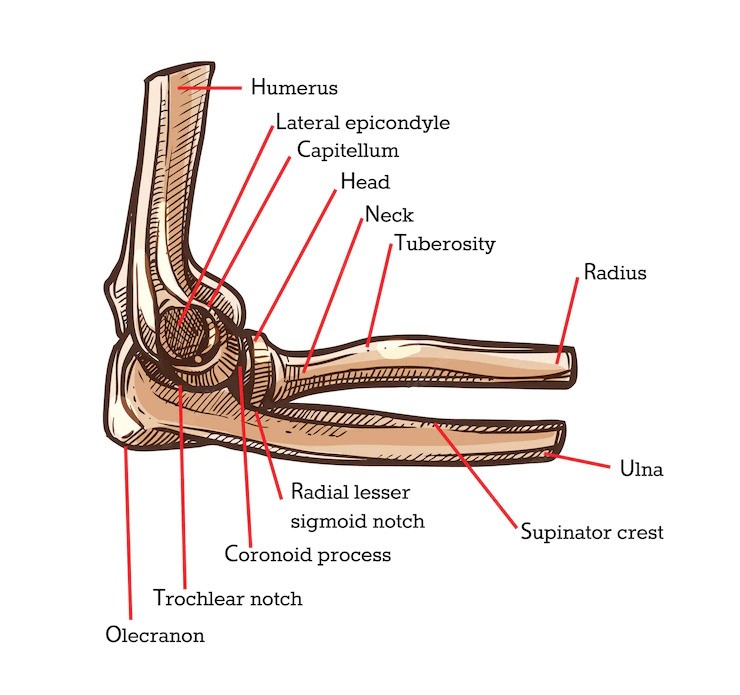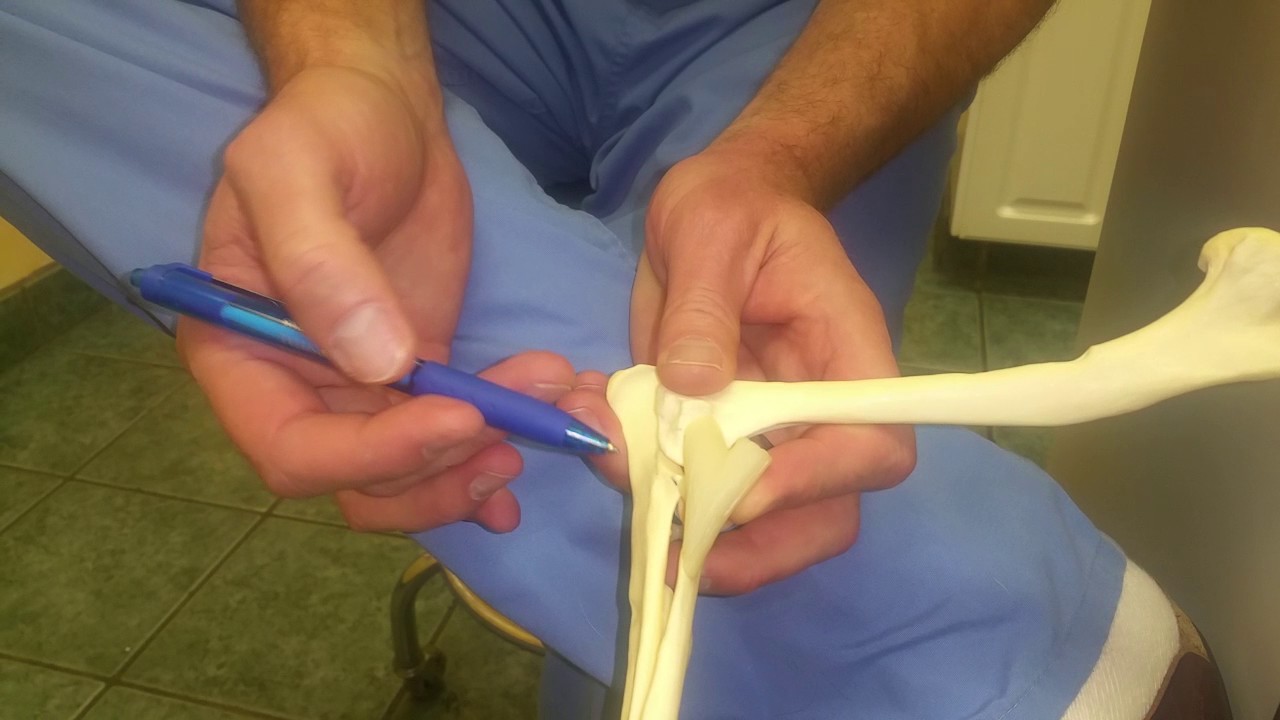Coronoid Process Of Ulna – It's Anatomy And Function
Coronoid process of ulna is a triangular feature that projects forward from the ulna's anterior proximal part.
Author:Suleman ShahReviewer:Han JuJul 08, 202277 Shares1.8K Views

The ulna is one of two bones that comprise the forearm; the other is the radius. It articulates with the radius proximally and distally and creates the elbow joint with the humerus. When the arm is in the anatomical position, it is positioned in the medial forearm. The bigger of the two forearm bones.
Coronoid process of ulnais a triangular feature that projects forward from the ulna's anterior proximal part. Coronoid process of ulna creates the anterior limit of the trochlear notch and is essential for elbow stability.
Structure Of Coronoid Process Of Ulna
It has a strong foundation that is continuous with the body of the bone.
Its tip is sharp, slightly bent upward, and is received into the coronoid fossa of the humerus during forearm flexion.
It has a smooth, convex top surface that forms the bottom half of the semilunar notch.
Its anteroinferior side is concave, with a rough imprint for the brachialis muscle insertion. The tuberosity of the ulna, which provides insertion to a portion of the brachialis, is located at the intersection of this surface and the front of the body; the oblique cord is linked to the lateral border of this tuberosity.
The radial notch is a thin, oblong articular depression on its lateral side.
Its medial side is used to attach a portion of the ulnar collateral ligament due to its conspicuous, free margin. A slightly rounded eminence at the front of this surface gives origin to one head of the flexor digitorum superficialis muscle; a depression behind the eminence gives basis to part of the flexor digitorum profundus muscle, and a ridge descends from the eminence gives foundation to one head of the pronator teres muscle.
A circular bundle of muscular fibers often emerges from the lower half of the coronoid process to form the flexor pollicis longus muscle.

Fragmented Coronoid Process
Function Of Coronoid Process Of Ulna
The coronoid process stabilizes and inhibits hyperflexion of the elbow joint. The coronoid process enhances the humeroulnar jo t articulation by securely grasping the trochlea of the humerus. The radial notch, which articulates with the head of the radius to produce the proximal radioulnar joint, is somewhat inferior and lateral to the trochlear notch.
The styloid process is a pointed bone projection that emerges from the ulnar head and is located distally on the ulna. With the forearm completely pronated, both of these structures may be palpated on the ulnar side of the dorsum of the wrist.
Coronoid Process Of Ulna Attachments
The coronoid process is a horizontal bony protrusion that directly joins the ulnar shaft. In elbow flexion, it is received into the coronoid fossa of the humerus. The coronoid process is also responsible for the bottom section of the semilunar notch.
The radial notch, where the head of the radius lies, is located on the lateral side of the coronoid process.
Coronoid Process Of Ulna Fracture
Coronoid process fractures are uncommon, and data is scarce. They are often associated with posterior dislocation of the elbow joint, although they may also occur as separate injuries. The coronoid process is fractured in up to 10% of all elbow dislocation patients. Because the coronoid process and the joint capsule to which it is linked are essential stabilizers of this joint, this may be a risk factor for repeated dislocations.
The coronoid process creates the front limit of the trochlear notch, whereas the olecranon forms the posterior barrier. The trochlear notch semicircularly traps the trochlea and is inclined posteriorly to avoid dislocation because the anterior capsule inserts just a few millimeters below the tip of the coronoid process; even minor avulsion fractures indicate a severe injury.
A significant loss of the coronoid process causes posterior elbow instability. When combined with radial head and/or lateral collateral ligamentous injuries, more minor coronoid fractures produce instability in more complicated and naturally occurring rotatory motions.
A significant cause of elbow dislocations is a fall on the extended hand, a common sports injury. The hand is considered stationary while the body generates valgus and posterolateral rotatory forces. As a result, the capsule and ligaments rip gradually from lateral to medial.
They fracture when the radial head and coronoid process collide with the distal humerus. Other damage modes include varus posteromedial injury mechanisms: A fall on the extended arm tears the lateral collateral ligament and fractures the anteromedial facet of the coronoid process. If the medial collateral ligament ruptures, the elbow will dislocate. The radial head may also fracture in such instances.
Coronoid Process Of Ulna Fracture Treatment
Treatment
- Nonsurgical immobilization for a short time, followed by early range of motion indications of types I, II, and III that are minimally displaced with the stable elbow joint.
- ORIF surgical procedure with indications for the medial approach
- Types I, II, and III with the chronic instability of the elbow
- Instability in the posteromedial rotatory plane
- ORIF with indications requiring a posterior approach
- Olecranon fracture-dislocation
- The dreadful trio of indications for an elbow hinged external fixation to assist preserve stability, big chunks of bone of low quality, and challenging revision cases
Techniques
ORIF with a medial approach medial exposure more anteriorly via a split in the flexor-pronator mass method approach medial exposure through an interval between two heads of FCU
When treating a type I injury, insert cerclage wire or a No. 5 suture through the ulna drill holes.
ORIF using retrograde cannulated screws or a plate for injuries of type II or III
ORIF with buttress plate fixation or pins and lateral ligament restoration is often performed for posteromedial rotatory instability.
Rehabilitation after surgery is contingent on the intraoperative assessment performed immediately after the operation.
A thermoplastic resting splint may be placed with the elbow at 90 degrees and the forearm in a neutral position. This will limit terminal extension to 30 degrees for two to four weeks.
Shoulder abduction should be avoided for four to six weeks to minimize varus moment on the arm. Early vigorous motion may promote dynamic muscle contraction. Once the ulnohumeral joint had been surgically repaired, there was a gap.
To access the coronoid fracture and check for related olecranon fracture dislocations, it is necessary to mobilize the olecranon fracture.
Before attempting to reduce the primary ulnar fracture in the olecranon, the coronoid fragment should be repaired using a dorsal plate and screws.
Complications
- Recurrent instability of the elbow, particularly on the medial side
- Rigidity in the elbow
- Arthritis caused by previous trauma
- Ossification in a heterotopic location
- Failure to detect and treat the underlying instability of the elbow, which occurred early on and contributed to the failure.
Prognosis
The risk of complications and further operations is significant.

Coronoid Process Fracture Treatment ,approaches Everything You Need To Know - Dr. Nabil Ebraheim
People Also Ask
Does The Ulna Have A Coracoid Process?
A triangular process that projects forward from the anterior proximal region of the ulna, the coronoid process of the ulna is one of the ulna's coronoid processes.
Where Does The Coronoid Process Take Place?
The terms"coronoid process" and "coronoid structure" are terms that are used to refer to two distinct human body structures. The first one may be discovered on the mandible, which is another name for the jawbone. One of the two coronoid processes may be found on the ulna, a long bone found in the forearm.
What Does The Coronoid Process Do?
The anterior joint capsule of the elbow, the brachialis muscle, and the medial ulnar collateral ligament are the three soft tissue insertions that contribute to the coronoid process's stability. The coronoid process acts as a bony buttress to prevent posterior dislocation, and it also has three soft tissue insertions that contribute to its stability.
What Is The Coronoid Process Of Ulna?
The coronoid process is a triangular prominence that projects forward from the ulna's top and front halves. It has a strong foundation that is continuous with the body of the bone. Its tip is sharp, slightly bent upward, and is received into the coronoid fossa of the humerus during forearm flexion.
Conclusion
Suppose we better understand the coronoid process of the ulna and its fractures. In that case, we will be able to manage them more effectively, which will lead to improved outcomes and a reduction in the likelihood of potential complications such as some degree of stiffness, neuropathy, and arthrosis.

Suleman Shah
Author
Suleman Shah is a researcher and freelance writer. As a researcher, he has worked with MNS University of Agriculture, Multan (Pakistan) and Texas A & M University (USA). He regularly writes science articles and blogs for science news website immersse.com and open access publishers OA Publishing London and Scientific Times. He loves to keep himself updated on scientific developments and convert these developments into everyday language to update the readers about the developments in the scientific era. His primary research focus is Plant sciences, and he contributed to this field by publishing his research in scientific journals and presenting his work at many Conferences.
Shah graduated from the University of Agriculture Faisalabad (Pakistan) and started his professional carrier with Jaffer Agro Services and later with the Agriculture Department of the Government of Pakistan. His research interest compelled and attracted him to proceed with his carrier in Plant sciences research. So, he started his Ph.D. in Soil Science at MNS University of Agriculture Multan (Pakistan). Later, he started working as a visiting scholar with Texas A&M University (USA).
Shah’s experience with big Open Excess publishers like Springers, Frontiers, MDPI, etc., testified to his belief in Open Access as a barrier-removing mechanism between researchers and the readers of their research. Shah believes that Open Access is revolutionizing the publication process and benefitting research in all fields.

Han Ju
Reviewer
Hello! I'm Han Ju, the heart behind World Wide Journals. My life is a unique tapestry woven from the threads of news, spirituality, and science, enriched by melodies from my guitar. Raised amidst tales of the ancient and the arcane, I developed a keen eye for the stories that truly matter. Through my work, I seek to bridge the seen with the unseen, marrying the rigor of science with the depth of spirituality.
Each article at World Wide Journals is a piece of this ongoing quest, blending analysis with personal reflection. Whether exploring quantum frontiers or strumming chords under the stars, my aim is to inspire and provoke thought, inviting you into a world where every discovery is a note in the grand symphony of existence.
Welcome aboard this journey of insight and exploration, where curiosity leads and music guides.
Latest Articles
Popular Articles
